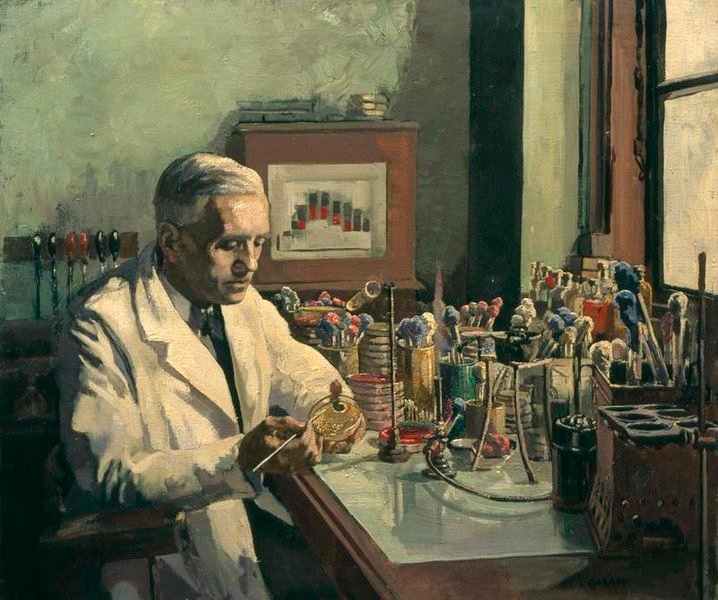The Discovery of Penicillin

I’m one of the many people who are allergic to the drug penicillin. I wasn’t always allergic. Before it developed penicillin and related drugs in the penicillin group of drugs knocked out a lot of the colds and chest infections I frequently had.
It was after I was working in the production area of these drugs for several years I developed a sensitivity to it. When I took an allergic reaction, my doctor informed me I had experienced the most severe that could be had without dying and the next one would kill me.
So, why on earth would I write about it now? Notwithstanding it’s potential to off me, penicillin has saved millions around the world and it was in September 1928 that it was discovered by Alexander Fleming.
Sir Alexander Fleming was born August 6, 1881 near Ayrshire, Scotland. His father was a farmer and Alexander was the third child. His upbringing in rural Scotland contributed to his capacity for observations and appreciation of the natural world at an early age.
He attended St. Mary’s Medical School, London University where her became a bacteriologist working in the field of vaccine therapy undr Sir Almroth Wright a pioneer in the field. Fleming soon showed a talent for technical ingenuity and original observation.
Early in his research he became interested in natural bacterial action in the blood and in antiseptics. He established a successful private practice I 1909 to 1914. He was one of the first doctors in Britain to administer the drug Salvarian which had been discovered by the German scientist Paul Ehrlich to treat syphilis.
He continued his work during his military career while serving as a Captain in the Army Medical Corp during WW1. He worked as a bacteriologist studying wound infection in a military hospital in France. He was able to demonstrate the use of strong antiseptics on wounds did more harm than good ad cleaning wounds with a mild saline solution was a safer alternative.
He returned to St. Mary’s after demobilization in 1918 and set to work developing an antibacterial that would not be toxic to animal tissue.
He had a breakthrough in September 1928 when he was working on a flu virus. He noticed mould had formed on a staphylococcus culture plate by accident. He also notd a bacteria free ring around the culture. This observation triggered him to further explore the mould and found that even when diluted 800 times the mould prevented the growth of the staph culture.
He named this new substance penicillin His discovery set off the field of antibiotics and led to even further research and development. Fleming continued to research and work on developing penicillin in the years leading up to WW2. He was unable to stabilize and purify it but knew the clinical potential was there.
During the war a team led by Howard Florey at the University of Oxford was bring penicillin into clinical use helping to save hundreds, if not thousands of military casualities.
FLeming was knighted in 1944. In 1945, Florey and his coworker Ernst Chain along with Alexander Fleming shared the Noble Prize.
The chance nature of Fleming’s discovery was picked up by the press and amplified. He was also more willing to talk to the press. From then until his death in April, 1955 Fleming received a lot of attention around the world for his discovery becoming something of an ambassador for medicine and science.
NOTE: Header image from Wikipedia; original image from Imperial War Museum and now in the public domain.

Shadowspub is a writer from Ontario, Canada. She writes on a variety of subjects as she pursues her passion for learning. She also writes on other platforms and enjoys creating books you use like journals, notebooks, coloring books etc.
NOTE: unless otherwise stated, all images are the author’s

Would you like to receive writing prompts regularly?
You can subscribe to Prompt A Day to get started.
Share your posts
- join us on the DreemPort Discord for PYPT
- Join DreemPort and take part by following @dreemport . Get eyes on your content and meet new friends.
https://twitter.com/ShadowsPub/status/1570544820879519744
The rewards earned on this comment will go directly to the people( @shadowspub ) sharing the post on Twitter as long as they are registered with @poshtoken. Sign up at https://hiveposh.com.
Thanks for your contribution to the STEMsocial community. Feel free to join us on discord to get to know the rest of us!
Please consider delegating to the @stemsocial account (85% of the curation rewards are returned).
You may also include @stemsocial as a beneficiary of the rewards of this post to get a stronger support.
Amazing that an accidental discovery saved so many lives!
It's really strange how one suddenly develops an allergy to something that never did any harm in the past and just how life-threatening it can be!
I'm allergic to many medications but thankfully not to penicillin, a medication the doctor told me once is one of the most effective antibiotics.
Thank you for sharing the story of this discovery with us, have a wonderful Friday @shadowspub!
our systems are a lot more individual than many of us realize. Logically the more exposure we have the more resistant we can become like against certain viruses. It does seem to defy logic that we become sensitive through continued exposure.
I'm also allergic to penicillin. As far as I know, it has been for my whole life, because when I was 3 or 4 I had a severe reaction to just a few drops (my brother was taking it for something and because I had a cold, my mother had me "lick the spoon" to help me get over it. The doctors sent me home from the hospital to die, telling my parents that there was nothing they could do (back then there wasn't, now there is) and that both they and I would be more comfortable with me at home.
While I was very young, I do remember a few things about that time. Due to the reaction, I couldn't walk or do a lot of things, so my father would carry me to the couch in the living room so I could be around everyone. I also remember my grandma looking at me and starting to cry when my dad pushed her out the door. I learned later that my parents didn't want me to know I was about to die, and her crying would make me question why.
Well, it's obvious I didn't die, because here I am, but I avoid penicillin and related drugs.
Whoa! That's a crazy story. The whole, "The doctors sent me home from the hospital to die..." threw me for a loop. I wasn't expecting that. Needless to say, I am glad the doctors were wrong. What a story.
!hivebits
Back then, I had no idea that my parents expected me to die. It wasn't until I was older that they told me the story. That's when I told them about my memory of my grandma crying and that I remembered my dad carrying me everywhere. They explained the why for both of those. I was partially paralyzed during that time. Every day my legs didn't work, some days my arms didn't work, either. I'm glad I don't remember all of that.
Geez, there is something to be said for not remember early childhood.
!hivebits
that's amazing that the docs just gave up like that. Some people are born with sensitivities to various things and others develop them over time.
I'm guessing that the rest is what let you survive the reaction?
They gave up because it was a time when they had nothing to combat it. Yes, I'm that old. Now there are medications to help with those allergies. Back then they had no idea what to do and people died due to a severe allergic reaction. Times have sure changed!
What helped me? I'm not sure. It could have been that I didn't have enough in my system (it was VERY little), or prayer, because I know there was a lot of prayer involved.
This history is a great motivation how things can be discovered by accident

!1UP
You have received a 1UP from @gwajnberg!
@stem-curator, @vyb-curator, @pob-curator, @neoxag-curator
And they will bring !PIZZA 🍕.
Learn more about our delegation service to earn daily rewards. Join the Cartel on Discord.
My greetings @shadowspub.
I would say that the more one is exposed to substances, the more intolerable ii becomes to us. I have a friend who worked as a bricklayer, a builder for more than 40 years till he became allergic to cement or concrete preparation, to such an extent that he quited and started to work as a security guard.
May I thank you for sharing Alexander Fleming's penicillin story, it refreshes our memory, thanking him, wherever he may be in the spiritual world, for giving to so many the opportunity to live longer lives.
Take care
we owe gratitude to many curious people who went before us for many life-saving discoveries.
Totally agreed.
Probably they did not set out to discover that, they wanted, from the very begining, though, due to their sense of observation, for being "curious people" as you said, is why we are where we are now.
Thanks again for sharing, @shadowspub